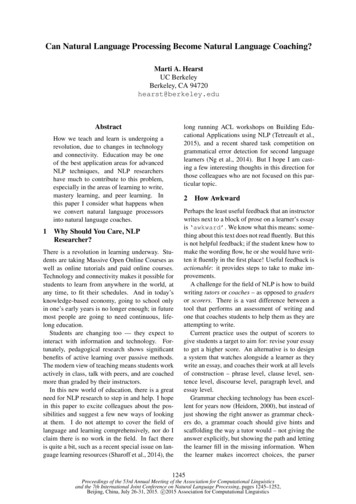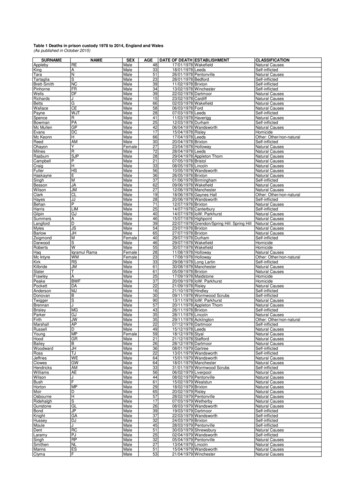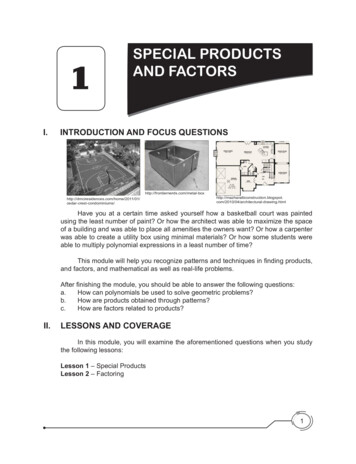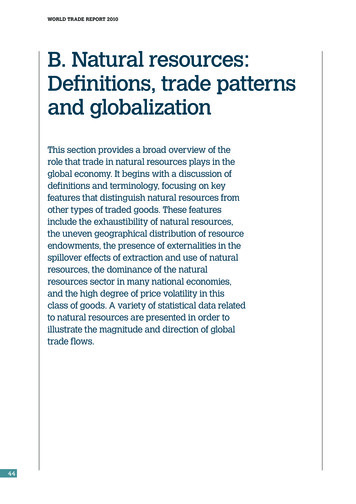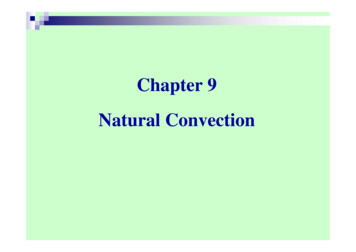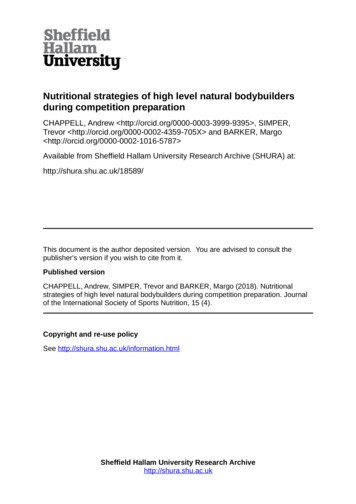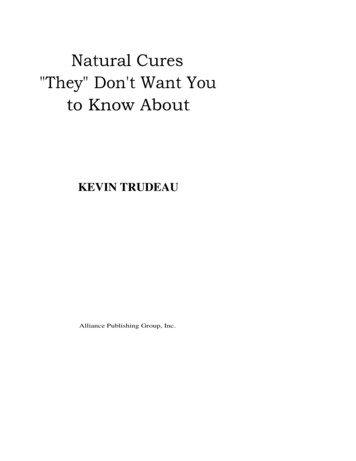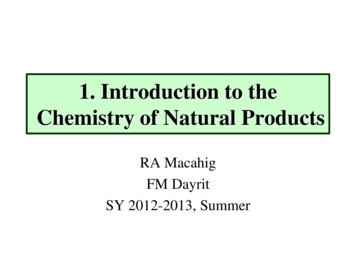
Transcription
1. Introduction to theChemistry of Natural ProductsRA MacahigFM DayritSY 2012-2013, Summer
"And the earth brought forth grass, and herbyielding seed after his kind, and the tree yieldingfruit after his kind, whose seed was in itself, andafter his kind: and God saw that it was good."-Genesis 1:121. Introduction to the Chemistry of Natural Products2
What are “Natural Products”?Chemical characteristics Naturally-occurring small organic compounds including heterocyclic compounds, and peptides. does not include proteins, carbohydrates, and nucleicacids. MW: 150 800 amu (“small molecule”) Methods of extraction and purification are generallysimilar to the techniques used for organic compounds(e.g., TLC, column chromatography, HPLC, GC) Methods of structural determination NMR, MS, IR, X-ray, UV1. Introduction to the Chemistry of Natural Products3
What are “Natural Products”?Biological characteristics Compounds are generally characteristic of a particularspecies or family, i.e., narrow taxonomic distribution (nonubiquitous) No nutritional or structural function. Functional roles mayinclude:- color (identification) - scent (attraction or repulsion)- sexual attraction- social communication- defense (e.g., plant toxins and antibiotics)but many still have unknown function in the organism inwhich they are found. Classified as “secondary metabolites” in contrast to1. Introduction to the Chemistry of Natural Products“primary metabolites”4
Diverse aspects of the Chemistry of Natural Products: Structural determination of natural products compounds Total synthesis or semi-synthesis of natural products; enzymesynthesis Determination of biosynthetic pathways using using planttissues, cell culture and isotopic labeling Pharmaceutical science: pharmacologic effects Functional foods, herbal medicines Agricultural science: antipest, allelopathy, IPM Ethnobotany Plant chemistry and plant development Biodiversity and Ecology; Marine natural products Chemotaxonomy and genetic classification Genomics and metabolonomics1. Introduction to the Chemistry of Natural Products5
Why study Natural Products? Natural products are the source of the most complex andfascinating chemical structures. Natural products represent biological diversity. Natural products are expressions of the genome. Natural products represent natural biological activity, whetheras single compounds or as complex mixtures. Natural products are part of the natural wealth of the country,and can be an important source of livelihood, from agricultureand food, pharmaceuticals, fine chemicals industry. Natural products can be an effective bridge from tradition tomodern scientific developments, including genetics, molecularbiology, biotechnology, and pharmaceutical science.1. Introduction to the Chemistry of Natural Products6
Range of products from natural products:1. Introduction to the Chemistry of Natural Products7
Range of products from natural products:1. Introduction to the Chemistry of Natural Products8
The market for natural products is HUGE Pharmaceuticals Traditional herbal medicines:US and Europe: gingko biloba, St. John’s wort, ginseng, garlic*,echinacea, saw palmetto, soya*, kava-kava, golden seal, aloe*, gotukola* (*also grown in the Philippines)India, China, Japan: Ayurverda, TCM, KampoPhilippines: lagundi, sambong, ampalaya, banaba, malunggay Beverages: tea (e.g., green, chinese), herbal teas, coffeeFood supplements and health productsFats and oilsHerbs and spices, food flavor ingredientsPerfumes and scentsEssential oils, others 1. Introduction to the Chemistry of Natural Products9
35/1853/F1)1. Introduction to the Chemistry of Natural Products10
(Philippine Daily Inquirer 06 June 2010 (Sunday), page A-19.)1. Introduction to the Chemistry of Natural Products11
(Philippine Star 06 June 2010 (Sunday), page B-9.)1. Introduction to the Chemistry of Natural Products12
Overview of Herbal Medicine Regulation in the World WHO recognizes the important and historical role ofherbal medicine in health. Herbal medicine is a majorform of treatment for more than 70% of the world'spopulation. The Guidelines for the Assessmentof Herbal Medicines states that asubstance’s historical use is a validway to document safety and efficacyin the absence of scientific evidenceto the contrary. Appropriate use Quality control methods Recommended ol herbalmed-drugreg.htm1. Introduction to the Chemistry of Natural Products13
Overview of Herbal Medicine Regulation in the World EU follows the "doctrine of reasonable certainty” and isgenerally consistent with WHO. France: traditional medicines can be sold with labelingbased on traditional use Germany considers active ingredient of herbal productand standardization (Commission E). England generally follows the rule of prior usehttp://www.holisticonline.com/Herbal-Med/hol herbalmed-drugreg.htm1. Introduction to the Chemistry of Natural Products14
Overview of Herbal Medicine Regulation in the World USA: herbal products can be marketed only as foodsupplements. Herbal products can make no specifichealth claims without FDA approval. Asia: use of patent herbal remedies composed of driedand powdered whole herbs or herb extracts, also in tabletform China: wide-spread use of traditional herbals Japan: Kampo medicine is derived from Chinesemedicine India: Ayurvedic ol herbalmed-drugreg.htm1. Introduction to the Chemistry of Natural Products15
Recommended Labeling Requirements for HerbalMedicine(a) name of product;(b) name and quantity (in dry weight when relevant) of activeingredient(s);(c) dosage form;(d) directions for use including indications, dosage, mode ofadministration, duration of use, age group limitations, and use duringpregnancy and lactation;(e) warning statements and relevant contraindications, adverseeffects, if any, and overdose information when relevant;(f) batch number;(g) expiry date;(h) storage conditions;(i) name and address of manufacturers and/or importers; and(j) registration or notification (listing) number.(Guidelines for the Appropriate use of Herbal Medicines, 1998, WHO)1. Introduction to the Chemistry of Natural Products16
The Changing Landscape of Herbal Medicine,Food and WellnessTraditional Medicine“is a comprehensiveterm used to refer both to TM systems, such astraditional Chinese medicine, Indian ayurveda andArabic unani medicine, and to various forms ofindigenousmedicine.TMtherapiesincludemedication therapies — if they involve use ofherbal medicines, animal parts and/or minerals —and nonmedication therapies such asacupuncture, and manual and spiritual therapies.“In countries where the dominant health care system is based onallopathic medicine, or where TM has not been incorporated intothe national health care system, TM is often termed“complementary”, “alternative” or “non-conventional”medicine.” (eg, US FDA: Complementary and Alternative Medicine)1. Introduction to the Chemistry of Natural Products17
The Changing Landscape of Herbal Medicine,Food and Wellness Herbal Medicine:Makes therapeutic claim; includescrude herbal materials, preparations and finished products,that contain as active ingredients, parts of plants orcombinations thereof. (WHO Traditional Medicine Strategy2002-2005). In Europe, also called “phytotherapy”. Dietary Supplement Nutriceutical Functional Food1. Introduction to the Chemistry of Natural Products18
The Changing Landscape of Herbal Medicine,Food and Wellness Herbal Medicine Dietary Supplement:A product that is intended tosupplement the diet and that bears or contains one or moreof the following dietary ingredients: a vitamin, mineral, herbor other botanical material, an amino acid, a dietarysubstance to supplement the diet by increasing the totaldaily intake. (US Dietary Supplement Health and EducationAct, 1994). Philippine FDA uses a very similar definition. Nutriceutical Functional Food1. Introduction to the Chemistry of Natural Products19
The Changing Landscape of Herbal Medicine,Food and Wellness Herbal Medicine Dietary Supplement Nutriceutical: Term coined by Stephen DeFelice in1989 from "Nutrition" and "Pharmaceutical". Zeisel (Science1999): Nutraceuticals are dietary supplements administeredin large dosages in order to obtain pharmacological effects.Nutraceuticals deliver a concentrated orm of a presumedbioactive agent from food, presented in a non-food matrix,in dosages that exceed those that can be obtained innormal food. Functional Food1. Introduction to the Chemistry of Natural Products20
The Changing Landscape of Herbal Medicine,Food and Wellness Herbal MedicineDietary SupplementNutriceuticalFunctional Food: A food that is consumed as part of anormal diet and which is claimed to have health-promoting ordisease-preventing properties beyond the basic function ofsupplying nutrients. Examples include probiotics (fermentedfoods with live cultures), prebiotics (e.g., inulin). This termwas first used in Japan in the 1980s where there is agovernment approval process for functional foods calledFoods for Specified Health Use (FOSHU).1. Introduction to the Chemistry of Natural Products21
The Changing Landscape of Herbal Medicine,Food and Wellness Herbal MedicineDietary SupplementNutriceuticalFunctional Food Natural Products Chemistryis key to all of these!1. Introduction to the Chemistry of Natural Products22
The study of natural products is multidisciplinaryBiology ChemistryTaxonomy . BotanyAgriculture .Organic synthesisPharmacology . Pharmaceutical Science .Organic analytical chemistryEntomology . Microbiology . Biotechnology/Molecular Biology . BiochemistryGenomics.ProteomicsMetabolonomics1. Introduction to the Chemistry of Natural Products23
Metabonomics offersthe opportunity to findpatterns of changes in theentire metabolism.(Donald Nicholson, International Union ofBiochemistry & Molecular Biologyhttp://pubs.acs.org/cen)1. Introduction to the Chemistry of Natural Products24
Natural products and bacterialsBacteria1. Introduction to the Chemistry of Natural ProductsChemotaxisCommunication25
A brief history of natural products chemistryAncientth19 centuryGreek Materia MedicaPharmacognosyPharmacology (to Medicine)thmid-20 ralproductschemistryMol Bio/BiotechComputationalst21 centuryConvergencee.g., Metabolonomics, synergy1. Introduction to the Chemistry of Natural Products26
Techniques used in natural products chemistry1800185019001950Type of research undertaken:Isolation, characterizationPharmacognosy & PharmacologyOrganic tic studiesBiochemistry; EnzymologyMolecular BiologyMetabolonomicsTechniques used:basic physico-chemical measurementsTLC column chrom GCX-ray UV-vis IRRadioisotopesEnzymesHPLC / ElectrophoresisMS / NMRComputational methodsTissue cultureMol Bio / BiotechCombinatorial chem1. Introduction to the Chemistry of Natural Products27
Modern directions in natural products chemistry: Genomics of bacteria and plants Novel and efficient synthetic methods Genetic engineering of bacteria and plants Enzyme synthesis Computational methods and modeling High efficiency chromatography Spectroscopic methods High-throughput screening Synergism Biotransformation1. Introduction to the Chemistry of Natural Products28
Natural Products as Sources of New Drugs(Ref: Newman, Cragg, and Snader, “Natural Products as Sources of New Drugs over the Period 1981-2002,”J. Nat. Prod. 2003, 66, 1022-1037)Natural products remain an important source of new structures,though not the final drug entity.IndicationTotal ortion100%10.54.624.044.515.01.213V236B: biologicals (peptides); N: nat prod extract; ND: semi-synthetic starting from nat prod; S: totallysynthetic using random screening ; SN: totally synthetic but based on nat prod; V: vaccineAlthough the combinatorial strategy has succeeded as a methodof optimizing structures, there is still no de novo combinatorialcompound that has made it to drug product.1. Introduction to the Chemistry of Natural Products29
Natural Products as Sources of New Drugs(Ref: Newman, Cragg, and Snader, “Natural Products as Sources of NewDrugs over the Period 1981-2002,” J. Nat. Prod. 2003, 66, 1022-1037)1. Introduction to the Chemistry of Natural Products30
Natural Products as Sources of New Drugs(Ref: Mark Butler, “The Role of Natural Product Chemistry in DrugDiscovery,” J. Nat. Prod. 2004, 67, 2141-2153)1. Introduction to the Chemistry of Natural Products31
1. Introduction to the Chemistry of Natural Products32
Some milestones in natural products HCH3OOStrychnineMorphine(aromatic alkaloid from opium, (aromatic alkaloid fromStrychnos nux-vomica)Papaver somniferum)Isolation: 1818, Pelletier &Isolation: 1806, SertürnerCaventouStructure: 1925, RobinsonStructure: 1946, RobinsonSynthesis: 1954, GinsbergSynthesis: 1954, WoodwardBiogenesis: 1959, Leete2001, EichbergNQuinine(quinoline alkaloid fromCinchona species)Isolation: 1820, Pelletier &CaventouSynthesis: 1944, Woodward1. Introduction to the Chemistry of Natural Products33
Some milestones in natural products chemistry:10CH3CH319CH372NCO2CH3OO8CH3NC6 H5HO4Camphor(monoterpene fromCinamomum camphora)Isolation: 1845, BouchardatCocaine(aliphatic alkaloid fromErythroxylon coca)Isolation: 1859, NiemannSynthesis: 1923: WillstätterConiine(aliphatic alkaloid fromhemlock, Coniummaculatum)Isolation: 1886, LadenburgStructure: 1926, Koller1. Introduction to the Chemistry of Natural Products34
Some milestones in natural products chemistry:2124201819CH3O glucoside1103HOSalicin(aromatic alcohol fromSalix species)Structure and synthesis:1906, Irvine51311OH N(H)CH325CH3CH2OH26231727CH CH CH314986Cholesterol(steroid from gallstones)Isolation: 1909, WindausStructure: 1932, WielandSynthesis: 1964, JohnsonBiogenesis: 1966, CornforthEphedrin(aromatic alkaloid fromEphedra equisetrina andE. sinica; "ma huang")Structure and synthesis:1920, Späth and Göring1. Introduction to the Chemistry of Natural Products35
Some milestones in natural products chemistry:arabinoseglucoseGinsengoside Rs2(Panax ginseng)Isolation and structure:1962, ShibataHOHOOHOOOOOHglucoseHOOHOHOBrevetoxin-A(red tide toxin fromGymnodinium breve)Structure: 1986, ClardySynthesis: 1987, OO. .OO.CHOOOO1. Introduction to the Chemistry of Natural Products36
Some milestones in natural products chemistry:AcOOPhO itumor diterpene fromPacific yew, Taxus species)Isolation: 1971, Wani et al.Structure: 1971, Wani et al.OCH3HAcOHOHOOOHDynemicin A(antibiotic polyketide fromMicromonospora chersina)Structure: 1989, Matsumoto and ClardySynthesis: 1991, NicolauBiosynthesis: 1992, Tokiwa et al.1. Introduction to the Chemistry of Natural Products37
Some milestones in natural products chemistry:OHOHOHOOHHOHOOOOHO( )-AbsinthinOHOOOHOHO(dimeric diterpene from Artemisiaabsinthium L., an anthelmintic)Isolation: 1953, HeroutStructure: NMR: 1980, Beauharie,X-ray: 1985, KarimovSynthesis: 2004, Zhang(-)-Littoralisone(neurotrophic growth factor, iridoidfrom Verbena littoralis L.)Isolation and structure: 2001, LiSynthesis: 2005, Mangion1. Introduction to the Chemistry of Natural Products38
Some milestones in natural products chemistry:Some recent rediscoveries:OHLauric acidOOHOleic acid9OOH15Linolenic acid912OH CH3H CH3H sterol(Provitamin D)Vitamin D3HO1. Introduction to the Chemistry of Natural Products39
Some milestones in natural products chemistry:(Terlau and Olivera, Physiol.Rev., 84: 41–68, 2004)Isolation and Structure: Olivera and Cruz and coworkers, 1984 onwards1. Introduction to the Chemistry of Natural Products40
The development of methods in organic chemistry islinked to developments in natural products chemistry:1800s Development of techniques in organic chemistry Wagner-Meerwein rearrangement in monoterpenesearly 1900s The early work on alicyclic chemistry was done on steroids1950 1980 Steric control of chemical reactions, e.g., borneol, steroids Studies by UV-visible spectroscopy (e.g., Vitamin A ) Development of NMR (2-D NMR, NOE)1980 present Recent synthetic methodologies Enzyme-mediated synthesis, cell culture, genetics andbiotechnology1. Introduction to the Chemistry of Natural Products41
The development of synthetic organic chemistry islinked to natural products chemistry: Robert Robinson, Nobel Prize in Chemistry in 1947:structure of steroid hormones and alkaloids, in particular,strychnine. Robert B Woodward, Nobel Prize in Chemistry in 1965:strychnine, lysergic acid and lanosterol: 1954; chlorophylland tetracycline: 1960; quinine, patulin, cholesterol andcortisone: 1965. Elias J. Corey, Nobel Prize in Chemistry in 1991 Koji Nakanishi-brevetoxin A, 1987 K.C. Nicolau-dynemicin A, 1991.1. Introduction to the Chemistry of Natural Products42
The role of the study of natural products today Nature still holds many secrets which we can learn from:chemical structure, biosynthesis, the role and relationshipof plants to other organisms. The study of natural products merges science withculture. For countries which harbor rich biodiversity, the study ofnatural products is an important way of developing one’snatural resources. Natural products should use the new developments, e.g.,molecular biology, computational science.1. Introduction to the Chemistry of Natural Products43
Issues and challenges in Natural Products today1. Loss of biodiversity2. Intellectual Property Rights Patent protection (pharma companies) Biopiracy (source countries)3. Western drugs:a. High cost of drug developmentb. New drug leads and targets4. Herbal products:a. Regulationb. Improvement in qualityc. Elucidation of mechanism of action1. Introduction to the Chemistry of Natural Products44
2009 Annual Review1. Introduction to the Chemistry of Natural Products45
Sustainable Drugs and Global Health Care(Ref: Geoffrey A. Cordell, Quim. Nova, Vol. 32, No. 5, 1356-1364, 2009)1. Introduction to the Chemistry of Natural Products46
Research areas in natural products today1. Structural elucidation (speed of analysis, sample throughput complexityof structures)2. Metabolonomics3. Synergy and biotransformation4. Biosynthesis5. Biological activitya. Ecologicalb. Pharmaceutical properties / drug discoveryc. Healthcare and cosmetic products6. Molecular biology and Biotechnology7. Quantitative natural products chemistry1. Introduction to the Chemistry of Natural Products47
Natural products chemistry is at the intersection ofmany fields:Ecological BiochemistryTaxonomyPharmaceutical tryCombinatorialChemistryBiotechnologyChemical synthesisMolecular BiologyMicrobiology1. Introduction to the Chemistry of Natural Products48
herbal medicine in health. Herbal medicine is a major form of treatment for more than 70% of the world's population. Overview of Herbal Medicine Regulation in the World The Guidelines for the Assessment of Herbal Medicines states that a substance’s hist

